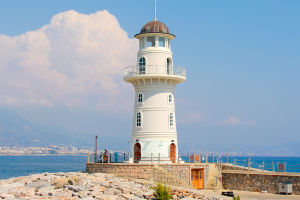Crossing vast expanses of water has always been a challenge for human connectivity, but with the advent of engineering marvels known as cross-sea bridges, distant shores are now seamlessly linked.
These architectural wonders have transformed transportation, opened up new opportunities for economic growth, and captivated the world with their grandeur. Let's delve into the fascinating world of cross-sea bridges and witness the triumph of human ingenuity.
One of the most renowned cross-sea bridges is the Jiaozhou Bay Bridge in China, stretching over 26 miles (42 kilometers) across the picturesque Jiaozhou Bay.
Completed in 2011, this engineering masterpiece surpassed all previous records, becoming the world's longest bridge over water. It not only facilitates smooth traffic flow but also offers breathtaking views of the bay's azure waters, making it a popular tourist attraction.
Moving westward, we encounter the Oresund Bridge, connecting Denmark and Sweden. This architectural marvel combines a cable-stayed bridge with an underwater tunnel, seamlessly merging two countries and cultures. Spanning over 10 miles (16 kilometers), the bridge not only serves as a vital transportation link but also represents a symbol of unity and cooperation between nations.
Closer to home, the Confederation Bridge in Canada stands as an iconic cross-sea structure. Extending over 8 miles (12.9 kilometers), it connects Prince Edward Island to the mainland, traversing the Northumberland Strait.
This engineering feat not only shortened travel times but also sparked economic growth and tourism on the island. The bridge's striking design, with its towering piers and sweeping curves, has made it an architectural landmark.
In the Gulf region, the King Fahd Causeway stretches over 16 miles (25 kilometers), connecting Bahrain and Saudi Arabia.
This vital lifeline has transformed transportation and trade between the two nations, fostering economic integration and cultural exchange. As you traverse the causeway, you are greeted by panoramic views of the azure Gulf waters, creating a sense of awe and adventure.
Crossing continents, we arrive at the astonishing Akashi Kaikyo Bridge in Japan. Towering above the turbulent waters of the Akashi Strait, this suspension bridge spans over 2 miles (3.9 kilometers), making it the world's longest suspension bridge.
Its elegant design and structural resilience allow it to withstand strong earthquakes and typhoon winds, demonstrating Japan's engineering prowess and commitment to innovation.
Cross-sea bridges not only bridge geographical gaps but also stimulate economic development in remote regions. They provide vital links for trade, transportation, and tourism, transforming isolated areas into thriving hubs of activity. These bridges connect people, cultures, and opportunities, fostering greater social integration and understanding.
Beyond their practical significance, cross-sea bridges captivate the human imagination. They stand as testaments to human determination, ingenuity, and a relentless pursuit of progress.
Their awe-inspiring structures become landmarks, drawing visitors from around the world who marvel at their architectural beauty and appreciate the seamless connectivity they provide.
Cross-sea bridges have revolutionized travel and connectivity, defying the limitations of geography. From the Jiaozhou Bay Bridge in China to the Confederation Bridge in Canada, these engineering marvels have reshaped landscapes, facilitated economic growth, and symbolized the triumph of human achievement.
They are not merely structures of steel and concrete but gateways to new horizons, bridging cultures and fostering unity. As we continue to push the boundaries of engineering and innovation, cross-sea bridges will remain a testament to our capacity to overcome obstacles and connect the world in extraordinary ways.


